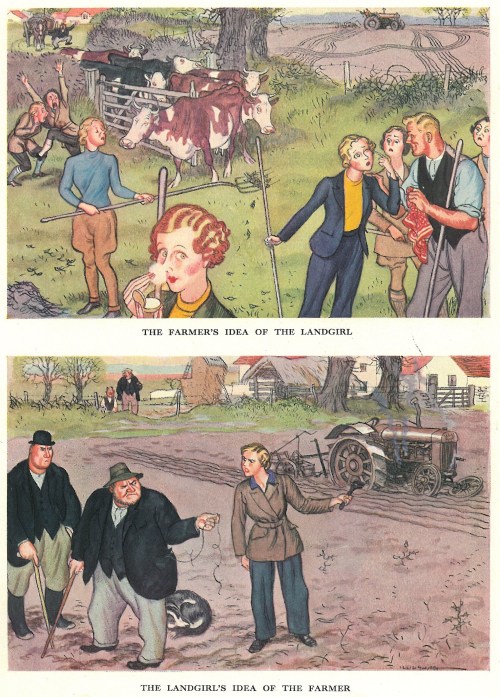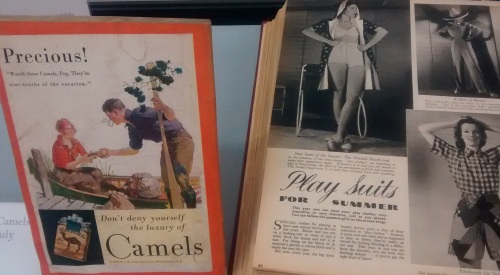Special Collections and Archives’ latest exhibition is curated by Dr Becky Munford and Amber Jenkins, School of English, Communication and Philosophy. The exhibition forms part of Becky’s wider research project into trouser wearing among women in Britain, France and America since the French Revolution. Becky’s website, ‘Women in Trousers: A Visual Archive’, will be launched later this summer.
The exhibition will be on display until early September. Extracts are supplied below.
Should women wear trousers?
From Joan of Arc to George Sand, Mary Edwards Walker to Marlene Dietrich and Colette to Coco Chanel, the history of trouser-wearing women in the West is vexed by controversy. Linked with periods of social and political upheaval, women’s liberation, radical thought, aesthetic innovation and erotic freedom, women in trousers have historically represented an illegitimate assumption of male authority and power – of ‘wearing the trousers’ – that destabilises fixed notions of sexual difference and threatens the ideology of the separate spheres.
‘Should Women Wear Trousers?’, Picture Post (1 November 1941), pp. 22-23.
‘Trousers For Women Are Not Necessarily Unattractive’, Punch (11 May 1927), p. 517.
Dress reform and ‘rational’ costume
The ‘bloomer costume’ was popularised by the American women’s rights activist and temperance advocate Amelia Bloomer in The Lily in 1851. Consisting of loose Turkish-style ‘trowsers’ worn under a short dress, the bloomer costume offered a ‘rational’ alternative to what Bloomer described as the ‘everlasting bondage’ of stays and petticoats. Although trousers had been worn by women in utopian socialist communities earlier in the century, bloomers represented the most radical challenge to fashionable dress because they wedded dress reform to feminist thought and political protest.
‘Woman’s Emancipation (Being a Letter addressed to Mr. Punch, with a Drawing, by a strong-minded American Woman)’, Punch (28 June 1851), p. 3.
‘Amelia Bloomer, Originator of the New Dress’, Illustrated London News (27 September 1851), p. 396 [first printed in The Lily (September 1851), p. 69].
‘The American Ladies’ New Costume’, Illustrated London News (19 July 1851), p. 85.
‘Bloomeriana. A Dream’, Punch (1851) pp. 204-205. Illustrated London News (19 July 1851), p. 85.
Irrational Rationalists
The intrigue and anxiety provoked by the sight of women wearing trousers in public unfolded across the printed pages of the popular press on both sides of the Atlantic. The British weekly magazine Punch focused its satire on the figure of the ‘strong-minded woman’, whose appropriation of trousers – a visual symbol of male power and privilege – was construed as a direct assault on masculinity. In the early 1850s, the magazine routinely offered derisive images of bloomer-clad women adopting ‘masculine’ poses, smoking cigars, proposing to men and terrorising their ‘hen-pecked’ husbands.
‘Bloomerism!’, Punch (1851), p. 189.
‘The Angel in ‘The House;’ Or, the Result of Female Suffrage (A Troubled Dream of the Future)’, Punch (14 June 1884), p. 279.
‘Sirens in Small-Clothes’, Lady’s Pictorial (25 April 1891), p. 654.
Free-wheeling feminism
The bloomer costume reappeared with the bicycle craze of the 1890s, and once again became the object of Punch’s caricature. The New Woman on a bicycle not only represented new locomotive freedoms for women, but also the possibility of broader social, intellectual and political freedoms. In 1896, the American women’s suffrage campaigner Susan B. Anthony declared that bicycling had done ‘more to emancipate women than anything else in the world’.
‘The Latest Craze in Paris: Lady Cyclists as Seen at Longchamps’, The Graphic (14 April 1894), front cover.
‘Fashions for November’, The Graphic (27 October 1894), p. 495.
‘The National Cycle Show’, The Graphic (15 December 1894), p. 682.
‘The Latest Parisian Craze’, The Graphic (14 April 1894), p. 420.
‘Bicycle Suit’, Punch (12 January 1895), p. 23.
‘A Girl Goes Cycling’, Picture Post (17 February 1940), pp. 42-43.
Wearing the trousers
The early decades of the twentieth century saw dramatic transformations in women’s dress to match the seismic changes taking place in the cultural, technological and political spheres. During the First and Second World Wars women adopted trousers to take up new modes of labour, working on the land, in munitions factories, as ship-builders, and as ambulance drivers and pilots, among other professions, preparing for and responding to ‘national emergencies’.
‘Farmers! Protect Your Crops by Using “Binks’s Patent Futurist Scarecrow”’, Punch (17 July 1918), p. 33.
‘The Farmer’s Idea of the Landgirl’, Punch (13 March 1940), n.p.
‘Ambulance Drivers in their War-Time Kit’, Picture Post (13 May 1939), p. 16.
‘Girl Pilots’, Picture Post (22 October 1938), p. 47.
Fashioning the modern woman
In the 1920s and 1930s, trousers became a more acceptable part of women’s attire for sports and leisure activities. Sportswear influenced the masculinisation of women’s fashion, while pyjama suits, and even shorts, became a part of fashionable women’s summer wardrobes. That trousers played a vital role in fashioning the idea of ‘modern’ femininity was also reflected in the association between trouser-wearing and smoking – trousers featured prominently in cigarette advertising of the period to suggest the freedoms promised by smoking for the modern woman.
‘Trousers – And All That – For Women’, Punch (18 May 1931), n.p.
‘Play Suits for Summer’, Picture Post (1 April 1939), pp. 52-53.
‘Advertisement for Camels’, Harper’s Magazine (July 1930), back cover.









Pingback: Should women wear trousers? - Betteridge’s LawBetteridge’s Law
Pingback: 5 Things Thursday: DAM; Adjusting; Cataloging | MOD LIBRARIAN
If it suits her then why not? Women wearing trousers is not a big deal today as it was in the 1960s. By reading your blog, I actually realized that it was such an old trend. Interesting post, I enjoyed reading it.
I am absolutely fascinated with your writings about women wearing trousers. This conversation is of upmost value for those of us interested in the history of fashion, but not just only from the aesthetic point of view. If one stops to think and really sees what caused such a fantastic revolution, one can see that the social, political, and economical situation of the times when trousres were introduced, created the perfect ground for trousers to survive and to stay, later of course!
Pingback: International Women’s Day and a Poetry Workshop – Emily Blewitt